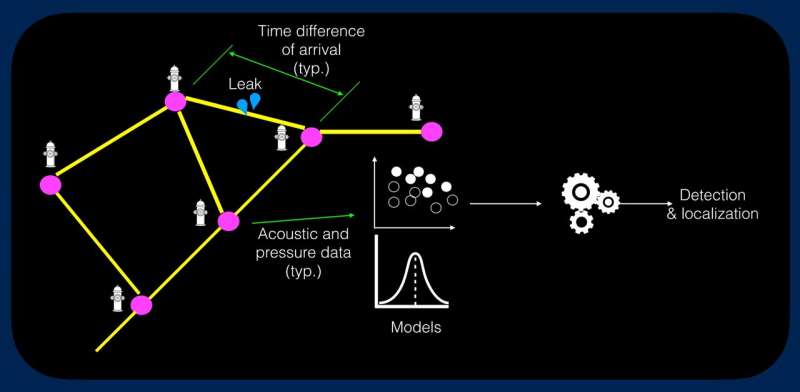This article has been reviewed according to Science X's editorial process and policies. Editors have highlighted the following attributes while ensuring the content's credibility:
fact-checked
trusted source
proofread
Fire hydrant hydrophones find water leaks

Access to clean drinking water is essential for healthy communities, but delivering that water is growing increasingly difficult for many utilities. Corroding pipes and land shifts in aging water distribution networks can create frequent leaks, wasting water before it ever gets to the tap. Utilities in the U.S. lose about 6 billion gallons of water a day—enough to fill 9,000 swimming pools—due to leaks, in addition to wasted energy and resources spent in collecting and treating that water.
Pranav Agrawal and Sriram Narasimhan from the University of California, Los Angeles discussed an innovative acoustic solution to identify and track leaks in water distribution networks in their talk, "Maximum likelihood estimation for leak localization in water distribution networks using in-pipe acoustic sensing." The presentation took place Thursday, May 11, as part of the 184th Meeting of the Acoustical Society of America.
Detecting a leak in a single straight pipe is not a challenge, but large urban networks can be a grid of hundreds or thousands of pipes, and precisely locating a leak is no easy task. Acoustic monitoring is the go-to solution, as the sounds from leaks are unique and travel far in water, but even this method struggles in complex pipe networks.
"Localization of the leak is complex as it involves factors like hydrophone density, the frequency bandwidth of the leak sound, and material properties of the pipe," said Agrawal. "It is impractical to have highly dense sensing that can localize leaks at any location in the network."
To tackle the problem, the researchers developed algorithms that operate on acoustic signals collected via hydrophones mounted on the most accessible parts of the pipe network: fire hydrants.
"We have developed algorithms which operate on acoustic data collected from state-of-the-art monitoring devices mounted on fire hydrants and 'listen' to the sound produced by leaks inside the water column," said Agrawal. "This device is now commercially available through Digital Water Solutions and has been deployed in various locations in Canada and the U.S., including in ongoing demonstration trials at the Naval Facilities Engineering and Expeditionary Warfare Center, Ventura County in California."
Attaching their sensors to fire hydrants means the team can avoid costly excavation and reposition the devices as needed. Combined with novel probabilistic and machine-learning techniques to analyze the signals and pinpoint leaks, this technology could support water conservation efforts, especially in the Western U.S, where this is direly needed.




















